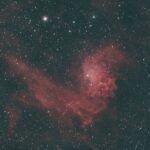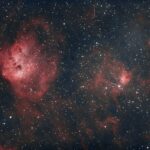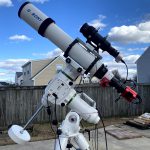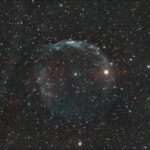
Continued collecting some more light from the Tadpole Nebula, the Spider Nebula, and the Fly Nebula through the AT66ED with the ZWO Duo-Band Filter. Ended up with 3 hours of light from 12/02 and 7 hours from 12/03. A total of 10 hours of data over two nights from these interesting objects in the Auriga constellation.
| Primary (Imaging) | Secondary (Guiding) |
|---|---|
| Scope: Astro-Tech AT66ED with .8 Focal Reducer (320mm – F/4.8) Filter: ZWO Duo-Band Ha/OIII Filter Camera: ZWO ASI294 MC Pro, Cooled to -10 C Focuser: Gemini Autostar Focuser Mount: Sky Watcher EQ6-R Pro |
Scope: SVBONY SV165 30mm F/4 Guide Scope Camera: Orion Star Shooter Autoguider (OSSAG) |
| Telescope Control, Image Acquisition, and Image Processing Software | |
|
Equipment Control and Imaging Software: NINA/PHD2/ASCOM on a Mini-PC Processing Software: GraXpert, Siril astronomical image processing tool, Siril’s Interactive Companion (Sirilic) |
|
I kicked off the second night of captures at 7:15 PM with the NINA Sequence set up to capture 7 hours using the same framing from the previous night. The sequence completed and the telescope parked at just after 3 AM on 12/04.
The Tadpole Nebula (IC 410) is to the right of center, the Spider Nebula (IC 417) is to the left of center, and the Fly Nebula (NGC 1931) is the bright nebula in the upper right. The open cluster NGC 1893 is located within the Tadpole Nebula. These emission and reflection nebulas are located in the constellation of Auriga.
This is 60 x 180 seconds captured on 12/02/2024 and 140 x 180 seconds captured on 12/03/2024 for a total of 10 hours of integration. Stacked using Sirilic. Then cropped, background extraction, and denoising in GraXpert. Final stretching and processing in Siril.

I did not apply any color calibration during the processing. When I did the photometric color calibration in Siril it washed out a lot of the contrast especially in the Tadpole Nebula. I think I can stretch the nebula a bit more… but like how this came out, especially the details in the Tadpole Nebula.
I used HubbleMatic in Siril to convert to the Hubble Palette.
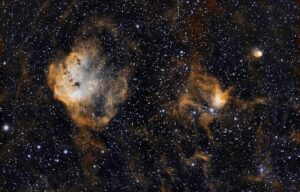
A bit more contrast in the details using the Hubble palette at the cost of some over saturated stars. I ran the HubbleMatic script after background extraction and denoising in GraXpert. Then used StarNet to pull out the stars and did a bit of adjusting with Siril’s Generalised Hyperbolic Stretch Transformation Tool to try to bring the brightness down a bit. Then recomposed the stars. Was able to get a bit more detail in the Spider Nebula which was not as well defined in the original color image.
Little more tinkering in Siril. Stretching the starless a bit more. I think I was able to get a bit better balance across the entire image. Little more detail in the Spider without blowing out the tadpoles.

The Fly also looks pretty good. I think this is my favorite so far.
Enjoyed this view of a few objects I had not visited in the past. Couple more clear nights in the forecast this week, going to move to something else for the next session. Looking forward to seeing what I can see.
Clear skies…



